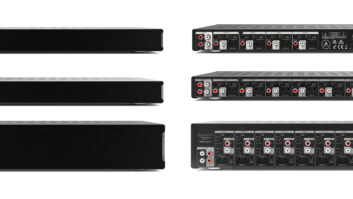Only a few years ago retailers were giving away three DVDs or DVD rentals with the sale of a (then) expensive DVD player.
These days, it is not too big an exaggeration to suggest that somewhere out there a retailer or online merchant is probably giving away a free DVD player with the purchase of three or four DVDs. Holiday season pricing will likely go below $25 this year for players and $199 for DVD recorders. Where does that leave the custom installation community, with DVD becoming both a must-have and a commodity product at the same time?
If that werent tough enough, there is a continuing round of format confusion that is more than enough to give even the most sophisticated client or prospect a big fat headache. DVD-Audio or SACD? Which DVD recordable format? HD-DVD or BluRay?
It certainly isnt easy, but as always, with a little information you not only save the sale, but continue to reinforce your reputation as the go to place in your community for products and services that meet the customers needs today and tomorrow. Before going too far, it is possible that at some level it is hard to compete with the under-$30 products that will be everywhere this season. That being said, you should at least have some ammunition to justify the pricing for the products that you sell other than the fact that they have a name brand on them to provide some comfort to the consumer.
Invest a few bucks on one of these low-cost marvels and you will quickly see that they do provide a reasonable picture and a digital audio output. That, however, is about it. They dont integrate into your complex control systems. They probably dont have component video outputs. They have very rudimentary remote controls whose codes are unlikely to be part of the built-in database of the universal remotes for your clients display.
Take some of the problem discs that may cause even brand name players fits. Will these no-name units play them? Burn some home movies in both the DVD-RW and DVD+RW formats. Will these units play them? Finally, look at the front-panel display on these units and compare the information that they provide and how they look to those on the players you carry. Did we forget to mention that a front-panel display on a bargain DVD player is as rare as the Patriots losing a football game?
Hopefully being able to put the issue of bargain players aside, the logical strategy is to go almost directly to products with DVD-Audio and/or SACD. While the number of software titles for either format isnt growing as fast as the hardware folks would like it, new titles are being added each month from both the majors and independent labels. Even DTS getting in to the act with discs such as the Blue Man Group that not only carry DVD-Audio and PCM DVD-Video tracks, but DTS 96/24 that justify the capabilities of more advanced processors or A/V receivers.
Moving a customer to a DVD-A, SACD or universal player helps separate your products from the cut-rate models, and brings with it all the other features the consumer likely expects at that level anyway. Why waste time selling features that the cheapo units have, but dont do as well, when it is easier to concentrate on those that they dont have at all?
To that end are DVD players with upscaling and HDMI connectivity. While they are not widely available now, expect these products to grow in number starting in the first half of 2005. If the former is part of the package, the latter (or DVI) is mandated. While the value of upscaling a signal from 480P to 720P or 1080I within the DVD player, as opposed to the scaling that would inevitably take place within the display is something that will vary from player to player as they are used with different sets, there is no denying the value of an all digital (DVI or HDMI) connection between the player and the display. Avoiding digital to analog, and then analog to digital conversions is something that is a very saleable and explainable benefit for any players you offer that are so equipped.
Moving further down the road, once pending copy protection and DRM issues are finally put to rest, HDMI will most likely emerge as a prime connection between DVD players with either of the two high resolution optical playback formats for audio and the processor or A/V receiver. If you are looking for forward-thinking features, this type of connectivity, or perhaps parallel capability with 1394 is something to keep on your radar.
As a side note, it is worth mentioning that the availability of DVD-Audio and/or SACD playback is also something to consider if you are called to validate the concept of a standalone DVD player against the latest Windows XP Media Center 2005 products. While, in some cases, those units represent an interesting alternative to conventional A/V products, keep in mind that they have no compatibility at this time with either of the two high-resolution DVD-based audio formats. Theres more to MCE 2005, however, but that is a topic for another time.
Selling against low-cost DVD players should be no more difficult that selling against low-cost, mystery brand plasma and LCD displays. Understand the feature and performance differences and be up front in pointing them out. Armed with the facts, it isnt that big a deal.
DVD recordables are more confusing. Here there are three underlying formats, with some variants that cross over the line to add up to a total of five possibilities: DVD-RAM, DVD-RW and DVD+RW erasable discs and DVD-R and DVD+R write once discs. This situation hasnt changed in the past few years, as all variations have dug in and none gives any indication of throwing in the towel.
For customers who want to transfer aging camcorder tapes and older home movies to the more permanent DVD format, or perhaps transfer some of the off-air programs they have archived on VHS or Beta tapes, a DVD recorder is a nice addition to their equipment stack. (As long as you remind them of copyright limitations of copying commercial content.) In those cases, the easiest course is to suggest a dual-format -/+ recorder so that they can avoid any possibility of format playback incompatibilities or unavailability of discs, but to some extent the choice of which record format to recommend comes down to the specific features of the machines you offer.
When looking at DVD recordables it may well turn out that these machines are destined to take a back seat to hard drive-equipped PVR products in the race to replace the VCR. That makes the case for a separate DVD player with all the high-end features and a full-featured, high-capacity PVR. Unless, that is, you combine the two features so that a PVR with its hard drive based time shift capability is combined with a DVD recorder. That combination is available in products with all level of features and hard drive capacity, coming from brands such as Pioneer, Toshiba, Humax, LiteOn and others. As always, look at the features and branding, and connectivity features to the list of items you and your clients need to consider.
All of the above wouldnt be so bad if there was time to absorb it all and fashion a sales strategy that will take you through the next year. Regrettably, while you do have to sell today against what is available today, to some extent you also have to sell against what isnt quite available today: another set of formats and products lurking in the background with the potential to throw everything you deal with now into an even more confusing state. It should be no secret to anyone that BluRay and HD-DVD are somewhere just over the horizon.
From a hardware and technology standpoint, both format camps have gone on record as saying that their component suppliers are ready to make it possible for eitheror bothformats in late 2005. Indeed, some of the decisions that have already been made are things that you will want to keep on your mid-term radar for upgrades to the systems of existing clients or for bids on systems that will be installed to a finish in late 2005.
On the video side, both high-def DVD formats will be compatible with three different video codecs: VC-1, an advanced form of MPEG-2 and the H.264 standard, also known as AVC, but more formally known as MPEG-4 Part 10. It is up to the software purveyors to decide which format to use on a given disc, and indeed some discs may use more than one, along with the added use of SD quality MPEG video for content such as those special features or archival material that does not benefit from HD due to the nature of the original production format. However, since the connection between the player and the display will almost certainly be in a single format (MPEG-2 MP/HL) acceptable to the display, the decoding for all three choices will take place within the player, thus making the whole thing transparent to the end viewer.
On the audio side, things are a bit different. Here, too, both format camps have agreed to use the same standards, Dolby Digital + and DTS ++. While it is probable that there will be multichannel analog audio outputs on the high def players, just as there are on todays DVD-Audio and SACD players, it is inevitable that the new audio formats will be available on the outputs at the HDMI or 1394 ports as well. Unknown at this point is the extent to which the pure high-resolution audio will be able to be ported out the same type of optical and coax SP-DIF-type connections in use today, and the degree to which these formats will be compatible with the decoders in current A/V receivers and processors.
Not wanting to obsolete the entire universe of existing surround sound gear, some mid-high bit rate versions of the new formats may be compatible with current products. However, as the bit rates eventually creep up beyond the limitations of todays equipments ports and the software capability of current processors, some upgrades will be required for clients who demand the best audio quality and player-to-processor digital connections and high-resolution decoding no matter what the bit rate.
With some of the specifications and details yet to be announced, at this point there are more questions than available answers. Perhaps things will become clearer after CES in January and certainly into the first quarter of next year when products that will be introduced in the fall of 2005 will need to be frozen. The moral here? When preparing for the future high-def DVD formats be careful about any promises you make about compatibility until all the facts are revealed.
At the same time, remember that while hardware is necessary for the launch of a format, so is the availability of software. After all, what good is a player if you have nothing to play on it? As we all hunker down for yet the latest edition of format wars that goes back to Tesla and Edison fighting it out over AC vs. DC currents over a hundred years ago, through the struggle between different speeds and sizes of vinyl recordings, audio tape and cassette formats, the epic struggle between Beta and VHS, and in more recent years the once mind-bending struggle between over a dozen proposed HDTV formats, XM vs. Sirius, DVD-Audio vs. SACD, the DVD recordable formats mentioned just above, and many more. In some cases warring formats were able to co-exist over the long term (such as Dolby Digital and DTS), in other cases one format simply faded away (as was the case of CED vs. Laser Disc, which, in turn eventually lost out to a DVD format that in itself was a merger), while in some other cases the whole concept fell away with none of the formats hanging in for the long term.
To paraphrase the old political clich, Its the software, stupid! While those of us who obsess about such things might like to think that technology and features are the be-all and end-all, at the end of the day no format, no matter how advanced, is able to succeed unless it has software support. With that in mind, the only studio committed to one of the two HD formats is Columbia Tri-Star, something that shouldnt be a surprise when you remember that Sony owns the studio. It is true that some of the other studios are part of the DVD-Forum or the BluRay promotion group, but the studio representatives themselves are the first to remind everyone that their participation in these groups does not mean that they will release discs in the particular format. Rather, they are correctly using format group participation as a means of insuring that should they go with a format, it will contain the copy control and content protection security features that they require.
Where does that leave a client who demands high-def DVD playback now? For the most part they will have to wait until the BluRay vs. HD-DVD format battle reaches a conclusion one way or another. Quite frankly, it is unlikely that any big studio titles will be available as packaged media in a high definition form for another year. In the mean time, those who want to show off their systems in true HD glory do have the option of playing the discs recorded with Microsofts WMV-HD codec through the use of an MCE 2005 computer or other high-powered Windows based system with the requisite processor power and video card.
DVD is certainly to be applauded as the format that has, in many respects, carried the consumer electronics industry for the past few years. It helped jump start player sales when VHS became a commodity, it certainly laid the ground work for the sale of digital A/V receivers and the replacement of earlier analog-format only multi-channel products, and it is still likely to be the content most watched on digital-ready video displays. For all of the good DVD has done for our industry, giving life to the home theater market, it is now, in some respects a commodity item. That should not prevent you from continuing to use it as a the core of playback systems, while at the same time continuing to monitor the formats continued metamorphosis into a high-resolution audio carrier, a recordable format, and eventually as a carrier for high definition video as a means unto itself to spur sales and maintain profitability.
Michael Heiss ([email protected]) is a technology and marketing consultant based in Los Angeles, California.







